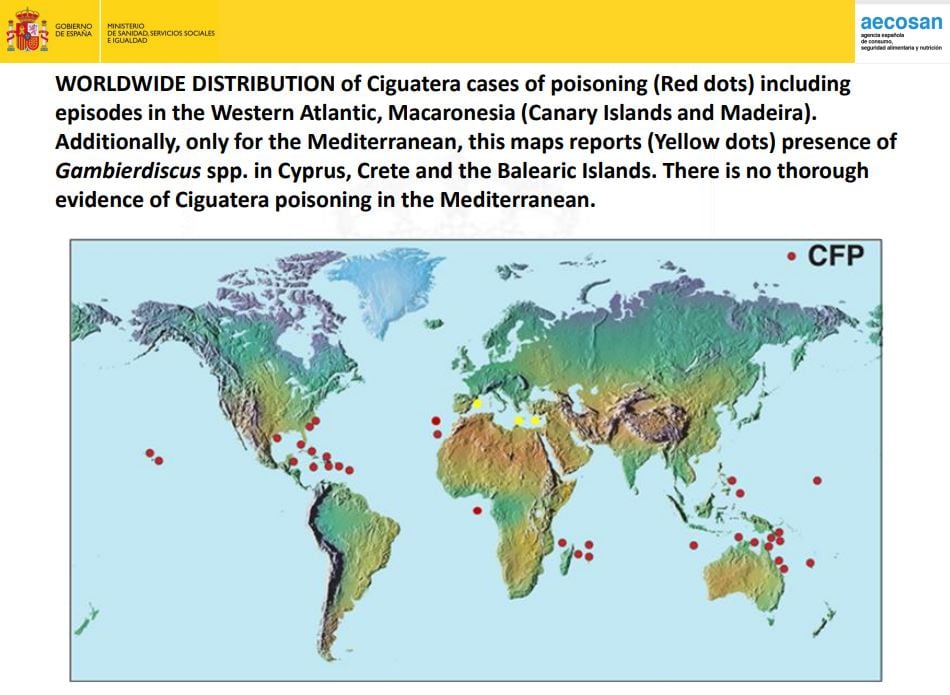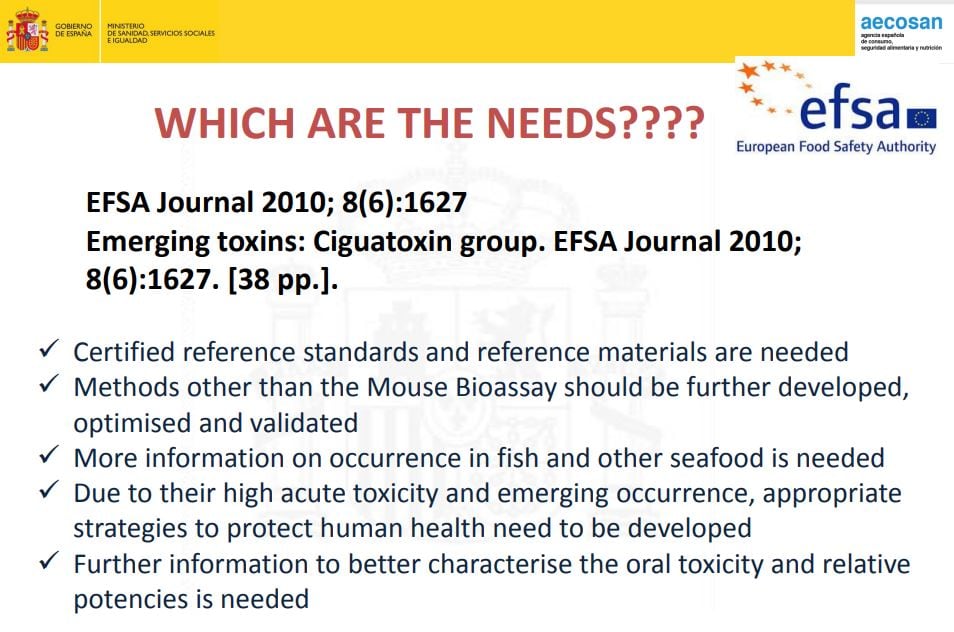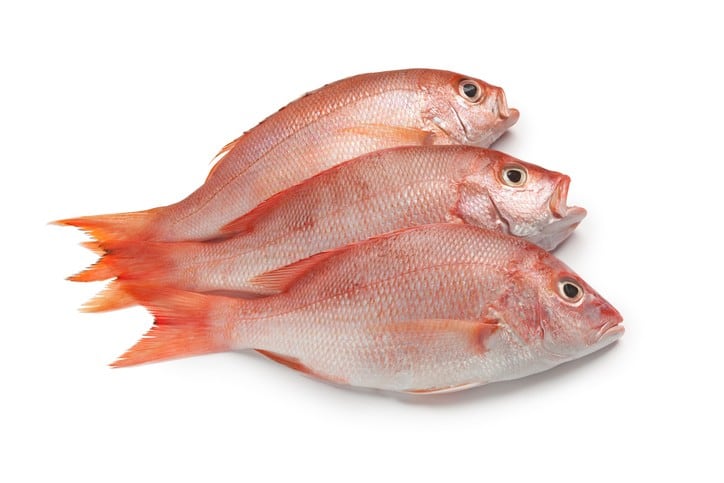Speaking at the FSAI (Food Safety Authority of Ireland) Conference in Dublin (August 21-22) to mark its 20th anniversary, Dr Ana Canals, AESAN, talked about the progress of a four-year ‘EuroCigua project’ with EFSA (European Food Safety Authority), with 15 European organisations belonging to six participating Member States (Spain, Portugal, France, Germany, Greece and Cyprus) studying the risk characterisation of ciguatera food poisoning in Europe, due to finish in September 2020.
Ciguatera prevention
The seafood-borne illness is typically caused by the consumption of fish that have accumulated ciguatoxins in their flesh produced by a certain microalgae cells (Gambierdiscus).
- As many as 50,000 cases of CFP worldwide are reported annually; the condition is endemic in tropical and subtropical regions of the Pacific Basin, Indian Ocean and Caribbean.
- Isolated outbreaks occur sporadically but with increasing frequency in temperate areas such as Europe and North America.
- Increase in travel between temperate countries and endemic areas, and importation of susceptible fish has led to the encroachment of CFP into regions of the world where CFP has previously been rarely encountered (Ting and Brown, 2001).
- In the developed world, CFP poses a public health threat due to delayed or missed diagnosis. Without treatment, distinctive neurologic symptoms persist, occasionally being mistaken for multiple sclerosis.
Consumers eating affected fish can suffer from a range of symptoms including gastrointestinal, cardiovascular and neurological effects.
While ciguatera cases used to be confined to tropical and subtropical regions of the world, Spain and Portugal have been reporting outbreaks of ciguatoxin poisoning on the Canary Islands and Madeira since 2008. In Germany, as well, there has been at least one ciguatera outbreak with up to 20 affected people every year since 2012.
Canals said it is working to raise awareness of the illness among member states and consumers because it is the only way to record it. One important part of the project is ciguatera prevention where the experts have created a leaflet outlining recommendations to reduce the risk of food poisoning in the affected regions.
“Ciguatera fish poisoning is a worldwide problem and outbreaks are on the rise in Europe and specifically CTX has increased 60% in the last decade. It is hard to build up reference material because the concentration of CTX on the flesh of fish is very low, you cannot clean it and it can lie on the liver and organs,” she said.
So far the project has concluded there are a number of contributing factors including climate change and globalised markets, but the disease requires more research to develop reference materials and standards and to monitor statistics on fish contamination.
“Ciguatera fish poisoning is an intoxication caused by a sea water toxin. Ciguatoxin is produced by microscopic organisms that produce gastro intestinal, neurological and cardio vascular symptoms it’s a pretty nasty syndrome that can last a long time and is the most common type of marine biotoxin food poisoning,” added Canals.
“It is estimated it can affect from anywhere between 10,000 to half a million patients a year but only around 20% of ciguatera fish poisoning is recorded so we are just looking at the tip of the iceberg.
“Most of the time, victims of ciguatera food poisoning don’t go to the doctor so it is not reported.
“We hear today a lot of reports about climate change, and there is still discussion about whether climate change is the cause of this epidemic as a result of rising seawater levels in certain areas but there is definitely a link between the toxin and global sea surface temperatures.
“We know that the first recorded outbreaks in Europe were in the Canary Islands in 2004 – Amberjack (Seriola rivoliana) 26kg: nine people affected and Madeira in 2008; Amberjack (Seriola rivoliana) 30kg: 16 people affected.
“It is becoming an increasing risk for European countries and it is becoming indigenous within the European Union member states.”
Gambierdiscus microorganism
As part of the EuroCigua project, the scientists hope to gain a better understanding of the time-based and geographic distribution in European waters of the Gambierdiscus microorganism responsible for the poisoning and are investigating whether fish from EU waters might contain ciguatoxin.
Fish should be a regular part of the diet, but the experts advise against eating the offal of tropical predatory fish, as they contain the highest ciguatoxin levels. Ciguatoxin is heat-stable and is not destroyed during the preparation of fish. It is colourless, odourless and tasteless and cannot be detected by the naked eye.
The main objectives of EuroCigua are to determine the incidence of ciguatera in Europe and the epidemiological characteristics of cases, to assess the presence of ciguatoxin in food and the environment in Europe, and to develop and validate methods for the detection, quantification and confirmation of the presence of ciguatoxin contaminated specimens. EU overseas territories in tropical areas are excluded of the scope of this project.

In Germany, the first reported ciguatera outbreak was in 2012, where 23 cases occurred after consumption of imported tropical fish (Lutjanus spp.), a red snapper.
A questionnaire was used to gather information on the disease course and fish consumption. All patients suffered from pathognomonic cold allodynia. Aside from two severe courses of illness, all other cases showed symptoms of moderate intensity.
During a three-year follow-up, seven patients reported prolonged paresthesia for more than one year. Two of them reported further neuropathies over almost three years. This is the first time that long-term persistence of symptoms has been documented in detail.
Outbreak cases were allocated to eight clusters in seven German cities. A further cluster was prevented by the successful recall of ciguatoxic fish. Three clusters were confirmed by the detection of ciguatoxin in samples of suspicious and recalled fish.
The ascertainment of cases and the outbreak investigations proved to be difficult due to inconsistent case reports to poisons centers, local health and veterinary authorities. In Germany, many physicians are unaware of the disease pattern of ciguatera and the risks caused by tropical fish.
The occurrence of further outbreaks during the following years emphasizes the increasing significance of ciguatera in Germany.
“Since 2012 we have had an alert for consumers in Europe for fish coming from endemic areas, in this case, the red snapper from Vietnam and India. That caused outbreaks in Germany and France,” said Canals.
“Currently there are no regulatory limits for CTX-group toxins in fish in Europe, but the regulation requires that no fish products containing CTX-group toxins are placed on the market.
“The fact is there is no official reference method for detecting CTX on fish or meat, there is no certified standard or reference material, we hardly have any toxicology data of these substances and seawater fish poisoning is not really well known in the European Union so it is also most likely underreported.”
Geographic reach
Historically, CFP was associated with isolated island communities that relied on subsistence fishing for their food supply but the geographic reach of CFP has expanded due to international seafood trade and travel.
In addition, people consuming fish from areas previously free of CFP may be at risk when such areas become prone to CFP due to changes in the aquatic environment.
“At the beginning of the EuroCigua project we wanted to work on a case definition because there are up to 40 different molecular types of CTX coming from the Pacific, Caribbean or India regions.
“We now have a universal definition and the project is working on defining the outbreaks since 2012. Endemic fish poisoning saw 93 cases from 16 sea water outbreaks from Spain and Portugal, but it’s hard to record cases because it is not a mandatory disease.
“The imported red snapper is coming mostly from India and Vietnam. Germany and France is the worst affected, Why France? France has a lot of tropical territories and they are used to sea water toxin symptoms, it is likely we will have more cases in Europe but the countries that have the most patients don’t recognise the symptoms.
“We have seen a total of seven seawater outbreak recordings and 72 seawater cases from imported fish from 2012-2018.”

Canals said it was believed CTXs are bioaccumulated and concentrated, meaning fish higher in the food chain tend to contain the highest CTX concentrations. However, recent studies from French Polynesia and Hawaii indicate a general lack of relationship between fish size and ciguatera toxicity for many species and families of fish, suggesting that fish size alone is not an adequate predictor of toxicity at least in those regions.
She added, the mouse bioassay (MBA) has been widely used to detect CTX-group toxins. However, due to insufficient detection capability and ethical concerns the MBA is not considered an appropriate method.
Liquid chromatography-tandem mass spectrometry methods can be of value for the quantification of CTX-group toxins, but certified reference standards and reference materials need to be provided to allow method development and (inter-laboratory) validation.
EuroCigua is now focusing on collecting microalgae from the environment and collecting fish from different locations, the western Mediterranean, Balearic Islands as well as Crete and Greece.
One area of interest is the Selvagens Islands, a remote group of Portuguese oceanic islands, located in the Northeastern Atlantic, 293 km southeast from Madeira Island, Portugal, 180 km north from Tenerife Island, Spain and 600 km west from the African coast.
Several outbreaks reported in the Canary Islands since 2004 derived from consumption of fish caught close to the Selvagens Islands. The cause of CFP in Portuguese waters has also been related to contaminated fish from Selvagens.
In the present study, CTXs was not detected in samples caught along the Madeira Island coast but were detected in most fish samples obtained from the further south Selvagens Islands. With the data available at the present day, reinforced with results of this study, it could be alleged the Selvagens islands are a hotspot of CTXs in Europe.
In future, the Selvagens may be used as a site for comparative CTXs occurrence in the Canary Islands and even Madeira. However, further studies involving intensive sampling in these remote Islands should be carried out to understand the Gambierdiscus dynamics, the toxin transfer in the food web and fish toxin metabolism.

